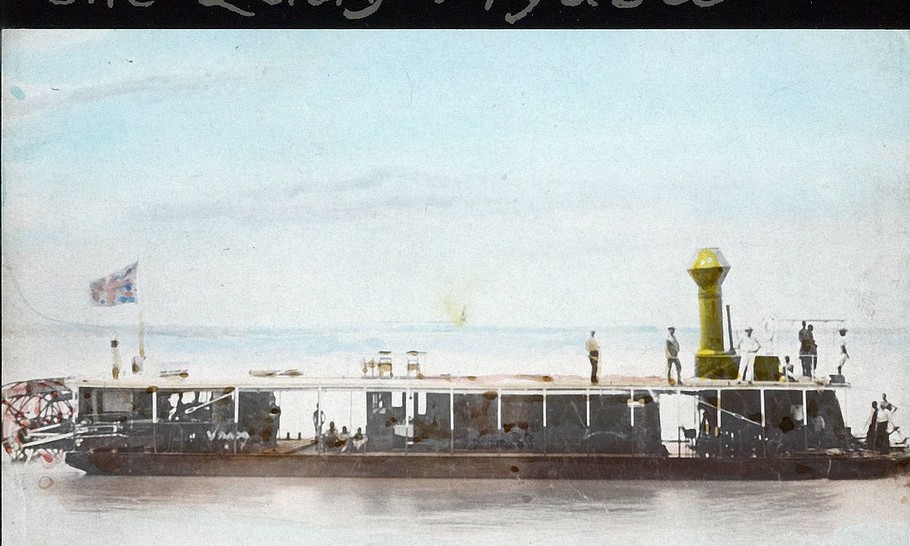Ships, looms and the human spirit

The Lady Nyasa Paddle Steamer, Africa, ca.1845-ca.1865
“The human spirit must prevail over technology” is one of Einstein’s better sayings – if he indeed said it. It would make a good protest banner in Silicon valley, or a classic essay topic, or the leitmotif in discussions about controlling nuclear weapons and AI, since there is no certainty that the human spirit will prevail.
There are many historical antecedents for such contemporary fears. Textile workers threatened by steam-powered looms participated in outbreaks of machine-breaking at the beginning of the 19th century. At the peak of resistance, 1810-1813, the government deployed 12,000 troops against them in Nottinghamshire, West Yorkshire and Lancashire, and made “machine-breaking” a capital offence. The pejorative term “Luddite” entered the language, meaning combative resistance to technology.
Later in the century, reactions to technology similar to our own were shared by Victorians from different classes. The polymath John Ruskin (1819-1900) was a spirited intellectual champion of craftsmanship versus industrial mass production. The Arts and Crafts Movement of the 1880s was led by the textile designer, businessman, artist and socialist, William Morris (1834-1896) whose wallpaper and fabric designs are still used worldwide.
But when it comes to the human spirit prevailing over technology, there are two stories, from the 19th and from the 21st centuries, that particularly deserve telling. Both feature that catchall for experience of change, “the journey”, and by coincidence feature Scotland. The technology is that of a Yarrow and Hedley steamship and a Hattersley treadle-powered loom. One was transported from Millwall docks (by Canary Wharf) to Lake Nyasa (now Malawi) in the 19th century, the other from the Isle of Lewis and Harris, in the Outer Hebrides, to Suffolk in the 21st.
The explorer and missionary David Livingstone was a Victorian celebrity. He gave the name of his birthplace, Blantyre, (South Lanarkshire), to the commercial capital of present day Malawi. Livingstone’s colleague, Lieutenant E.D. Young, a naval officer, was also a missionary hero, though little known today. In 1862, Young shipped out a steamboat to Africa for Livingstone. Like a giant IKEA delivery, the Lady Nyasa was transported in flat-pack form to bypass the Murchison Falls, a long and fierce section of rapids on the Shire River, in order to reach Lake Malawi. Reassembled, Young captained it until 1864. But the mission was recalled by the British government and Young left the navy to become a coastguard at Dungeness.
A brief digression on a little-known use of the steamship: a colleague of mine in Malawi in the 1960s collected an oral tradition from an old man whose grandfather, never having seen a white man before, had met the great Scottish missionary. Livingstone’s appearance set off a huge debate. Was this uninvited visitor a spirit, mzimu, or another human being, munthu? A spirit, they decided, would not have normal bodily functions. So they kept him under observation. But Livingstone retreated to the steamship for this purpose, and the question remained unresolved. The word used for the white man today is mzungu.
After Livingstone’s death in 1873 at Ilala in today’s Zambia, the Free Church of Scotland made another attempt to plant a mission in what was then Nyasaland, employing a young United Presbyterian Minister, Rev. Dr. Robert Laws, as a medical missionary. So Young was summoned from Dungeness to the perilous waters of the Shire river with another steamship, the 48ft. Ilala, also reduced to manageable crates full of steel plates plus nuts and bolts – they had arrived rusty in Cape Town – each crate weighing 23 kilograms. The two boilers could only be broken down into three pieces each and were much heavier. Some 600 African porters carried these crates through forest and up steep climbs around the Falls for reassembly by the engineers, carpenters and metalworkers of the mission team. The Ilala plied the lake for many years and, for some fifty years, Laws built up the Livingstonia Mission in the healthy uplands of northern Malawi. It was here that the Malawian nationalist elite were schooled alongside Kenneth Kaunda, the future first President of Zambia. This year was the 150th anniversary of Livingstonia’s founding.
Inhabitants of Suffolk should not be unduly overawed by such heroism. My second journey story is, in its smaller scale and quieter way, something of an epic. It is about a journey in 2016 from East Anglia to the furthest tip of Britain by James Jenkins, a youth worker who had taken up weaving, and his wife Katie, a primary school head teacher. Their less evangelical aim was to buy one of the last surviving Hattersley Treadle-powered domestic looms and bring it home. It had taken a year to locate one. The only boat involved in their journey was the ferry plying between Uig on Skye and Tarbet on Harris, in the usual teeming rain and churning sea. Starting near the Suffolk coast, driving an old Land Rover and towing a trailer, they took two and a half days to reach the island of Harris.
The Harris tweed weavers did not look kindly on anyone selling a home loom to the English. But the Jenkinses had come to buy a loom that had sat unused for decades from a couple who had recently moved to the Island. The purchase was in all senses counter-cultural. James and Katie stayed on the edge of the village of Arnol on the old coastal road for 3-4 nights in a converted Blackhouse (the museum held an original Blackhouse with its sooty open fire and hole in the roof). The loom was less quaintly housed against a wall in a dilapidated shack open on one side, was rusted and contained birds’ nests. Such looms varied in weight between 300-400 kilograms. They had been told not to worry, help would be at hand. It wasn’t. Katie even briefly contemplated calling it a day and renaming their trip a holiday. But they did get the loom back to Suffolk.
Then came many years of restoration work in a Sudbourne Park workshop near Orford: learning metalwork, manufacturing the loom’s unique nuts and bolts, struggling with the tension of the warp, repairing and designing, and generally learning the skills of a 19th century home weaver.
The old crofter weavers are still retained on Harris, but large mills, sometimes owned by international investors, do a lot of the work. Katie and James weave and do everything else, preparation and design, themselves. The final product was, and is, of the highest quality: beautiful blankets and scarfs, [enquiries@mabeland.co.] a challenge to branded, industrialised and — inevitably — lower quality modern textiles.
Livingstone and Lieutenant Young and their rusty steamship, Katie and James Jenkins and their rusty loom: both exemplify the age-old story of Humanity’s control over Metal and Machines. Two journeys, two triumphs of the human spirit coming to grips with technology. Both, in their different ways, magnificent.
A Message from TheArticle
We are the only publication that’s committed to covering every angle. We have an important contribution to make, one that’s needed now more than ever, and we need your help to continue publishing throughout these hard economic times. So please, make a donation.





